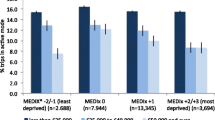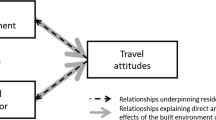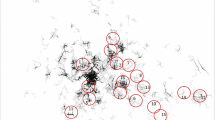Abstract
This study examined the effects of land use and attitudinal characteristics on travel behavior for five diverse San Francisco Bay Area neighborhoods. First, socio-economic and neighborhood characteristics were regressed against number and proportion of trips by various modes. The best models for each measure of travel behavior confirmed that neighborhood characteristics add significant explanatory power when socio-economic differences are controlled for. Specifically, measures of residential density, public transit accessibility, mixed land use, and the presence of sidewalks are significantly associated with trip generation by mode and modal split. Second, 39 attitude statements relating to urban life were factor analyzed into eight factors: pro-environment, pro-transit, suburbanite, automotive mobility, time pressure, urban villager, TCM, and workaholic. Scores on these factors were introduced into the six best models discussed above. The relative contributions of the socio-economic, neighborhood, and attitudinal blocks of variables were assessed. While each block of variables offers some significant explanatory power to the models, the attitudinal variables explained the highest proportion of the variation in the data. The finding that attitudes are more strongly associated with travel than are land use characteristics suggests that land use policies promoting higher densities and mixtures may not alter travel demand materially unless residents' attitudes are also changed.
Similar content being viewed by others
References
Alonso W (1964) Location and Land Use.Cambridge, Mass.: Harvard University Press.
Cervero R (1989) America's Suburban Centers: The Land-Use Transportation Link.Boston: Unwin Hyman.
Dobson R, Dunbar F, Smith CJ, Reibstein D & Lovelock C (1978) Structural models for the analysis of traveler attitude - behavior relationships. Transportation 7: 351-363.
Ewing R, Haliyur P & Page GW (1994) Getting around a traditional city, a suburban planned unit development, and everything in between. Transportation Research Record 1466: 53-62.
Frank LD & Pivo G (1994) Impacts of mixed use and density on utilization of three modes of travel: Single-occupant vehicle, transit, and walking. Transportation Research Record 1466: 44-52.
Friedman B, Gordon SP & Peers JB (1994) Effect of neotraditional neighborhood design on travel characteristics. Transportation Research Record 1466: 63-70.
Giuliano G (1989) New directions for understanding transportation and land use. Environment and Planning A 21: 145-159.
Goodwin PB (1975) Variations in travel between individuals living in areas of different population density. Planning and Transport Research and Computation Summer Annual Meeting, July.
Gordon P, Richardson HW & Jun M-J (1991) The commuting paradox: Evidence from the top twenty. Journal of the American Planning Association, Autumn: 416-420.
Goulias KG and Kitamura R (1993) Analysis of binary choice frequencies with limited cases: Comparison of alternative estimation methods and application to weekly household mode choice. Transportation Research 27B(1): 65-78.
Handy S (1992) How Land Use Patterns Affect Travel Patterns: A Bibliography.CPL Bibliography No. 279. Chicago: Council of Planning Librarians.
Handy S (1993) Regional versus local accessibility: Implications for non-work travel. Transportation Research Record 1400: 58-66.
Hanson S & Schwab M (1987) Accessibility and intraurban travel. Environment and Planning A 19: 735-748.
Howard/Stein - Hudson Associates (1993) The Impact of Various Land Use Strategies on Suburban Mobility. Prepared for Middlesex Somerset Mercer Regional Council. Available through NTIS, 5285 Port Royal Road, Springfield VA 22161 (phone 703-487-4650), Report No. FTA-NJ-08-7001-93-1.
Kitamura R, Laidet L, Mokhtarian PL, Buckinger C & Gianelli F (1994) Land Use and Travel Behavior. Report prepared for the State of California Air Resources Board, Research Report UCD-ITS-RR-94-27, Institute of Transportation Studies, University of California, Davis, CA, October.
Levinson HS & Wynn FH (1963) Effects of density on urban transportation requirements. Highway Research Record 2: 38-64.
Lyon PK (1984) Time-dependent structural equations modeling: A methodology for analyzing the dynamic attitude - behavior relationship. Transportation Science 18(4): 395-414.
McNally MG & Ryan S (1993) A comparative assessment of travel characteristics for neotraditional developments. Paper presented at the 72nd Annual Meeting of the Transportation Research Board, Washington, D.C.
Mogridge MJH (1985) Transport, land use, and energy interaction. Urban Studies 22: 481-492.
Muth R (1969) Cities and Housing.Chicago: University of Chicago Press.
Newman PWG & Kenworthy JR (1989a) Cities and Automobile Dependence: A Sourcebook.Brookfield: Gower Technical.
Newman PWG & Kenworthy JR (1989b) Gasoline consumption and cities: A comparison of US cities with a global survey. Journal of the American Planning Association, Winter: 24-37.
Pendyala RM (1993) Causal Modeling of Travel Behavior Using Simultaneous Equations Systems: A Critical Evaluation. Ph.D. Dissertation, Department of Civil Engineering, University of California Davis. University of California Davis Institute of Transportation Studies Research Report Number UCD-ITS-RR-92-19.
Prevedouros PD (1992) Associations of personality characteristics with transport behavior and residence location decisions. Transportation Research 26A(5): 381-391.
Pushkarev B & Zupan J (1977) Public Transportation and Land Use Policy.Bloomington: Indiana University Press.
Steiner RL (1994) Residential density and travel patterns: Review of the literature. Transportation Research Record 1466: 37-43.
Tardiff TJ (1977) Causal inferences involving transportation attitudes and behavior. Transportation Research 11: 397-404.
Tischer ML & Phillips RV (1978) The relationship between transportation perceptions and behavior over time. Transportation 8: 21-36.
Wachs M (1993) The role of land use strategies for improving transportation and air quality. Introductory remarks to the UCLA Extension Public Policy Program Symposium on the Transportation/Land Use/Air Quality Connection, Lake Arrowhead, California, November.
White Mountain Survey Co., Inc. (1991) City of Portsmouth, N.H. Traffic/Trip Generation Study. Prepared for Merwin and Associates, Rancho Cordova, California, December.
Author information
Authors and Affiliations
Rights and permissions
About this article
Cite this article
Kitamura, R., Mokhtarian, P.L. & Laidet, L. A micro-analysis of land use and travel in five neighborhoods in the San Francisco Bay Area. Transportation 24, 125–158 (1997). https://doi.org/10.1023/A:1017959825565
Issue Date:
DOI: https://doi.org/10.1023/A:1017959825565




